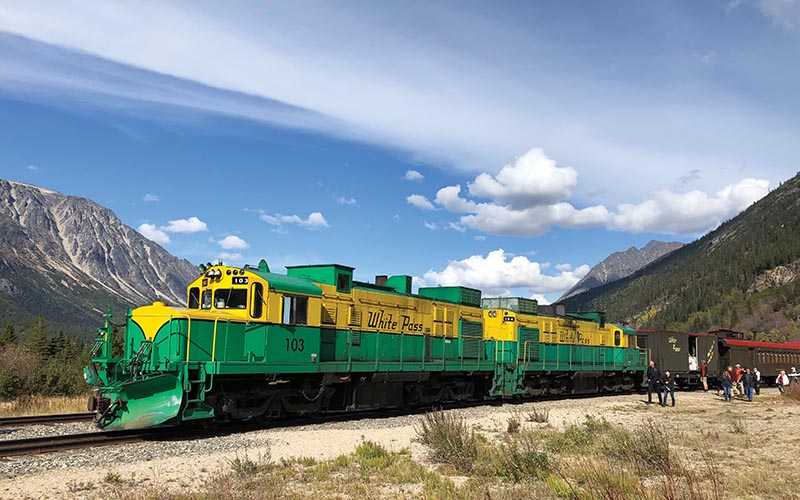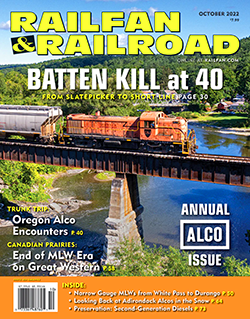 By Randy Babcock and Mike May/photos as noted
By Randy Babcock and Mike May/photos as noted
It might seem odd to say that there was a lot of change occurring on American narrow gauge railroads as late as 1968, but in fact, there was. In Colorado, Denver & Rio Grande Western ran its final narrow gauge freight train in early December and finally achieved its decade-long goal of abandonment of the narrow gauge lines, save, of course, for the immensely popular Silverton Branch originating in Durango. In an isolated corner of southeast Alaska, White Pass & Yukon was trending in the complete opposite direction, making huge capital infrastructure investments with the signing of a massive contract to haul ore from the Cyprus Anvil Mining Corporation’s Faro Mine. WP&Y was also leading the world on the cutting edge of developing the world’s first purpose-built intermodal container transportation system. WP&Y was modernizing its then-70-year-old narrow gauge railway as a key link in its ship, rail, and highway transportation network from the deep water port in Skagway, Alaska, into the Canadian Yukon Territory.
With this massive growth happening and the advanced age of White Pass’s inadequate fleet of 90-series General Electric shovel-nose diesels, there was a clear need to invest in new power. About the same time that Richard Nixon was elected president, WP&Y placed an order for seven DL535 three-foot-gauge, 1,200-hp locomotives from Alco. The locomotives were built with Alco 6-251D prime movers, 764 traction motors, multiple-unit (m.u.) capabilities, and six-axle C-C wheel arrangements. The units were to be built in Schenectady, N.Y., as road numbers 101 through 107 (construction numbers 602301–602307).
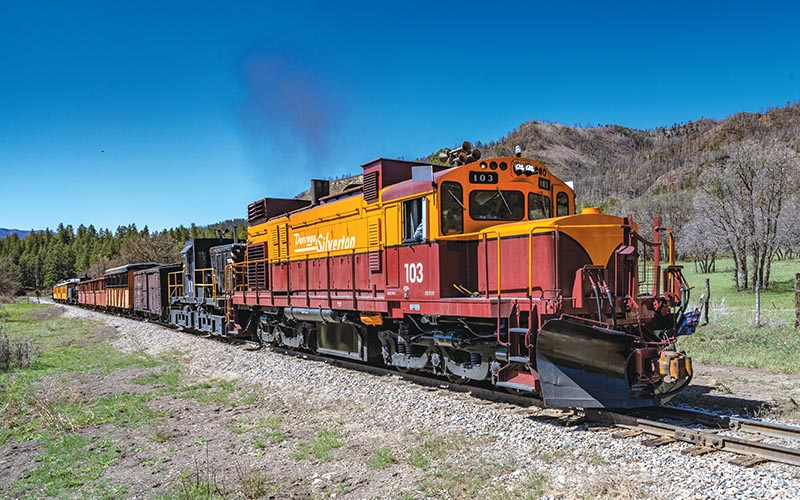
ABOVE: With an assemblage of equipment representing no fewer than five different narrow gauges, 103 heads a consist of support equipment up the 2.5 percent grade of Hermosa Hill, just south of Rockwood. —Jerry Day photo
Before their completion, Alco ended locomotive manufacturing at Schenectady, and in early 1969 transferred the completion of the units to subsidiary Montreal Locomotive Works (MLW). At virtually the same time Neil Armstrong was taking man’s first steps on the moon, the seven DL535s began to arrive in Skagway.
Just as the railroad was receiving its new power on October 15, 1969, a tragedy of Shakespearian proportions occurred. Locomotives 102 and 105 met their end before ever turning a wheel in revenue service when they were trapped inside the Skagway roundhouse as it burned to the ground. The fire was devastating to the railroad, having destroyed or damaged much of the equipment housed inside. The five other members of the DL535 fleet were left unharmed and soon began their 53-year-long careers.
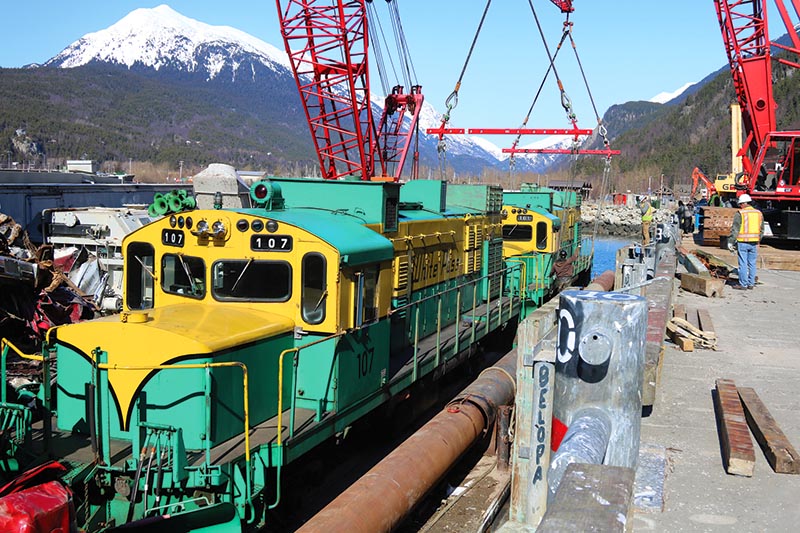
ABOVE: It’s April 2020, and while most of the world is still indoors, 101 and 107 have just been loaded in Skagway for their journey to Durango. —Mark Taylor photo
With new business on the horizon, White Pass wasted no time in replacing the brand-new locomotives that had been lost in the fire. Orders were placed with MLW to build three more DL535s like those that had just been delivered. Locomotives 108, 109, and 110 were built in December 1971 and joined their older siblings in hauling ore, freight, and passengers on the 110-mile railroad between Skagway and Whitehorse.
The railroad saw good years during the 1970s as the DL535s and the older GE shovel-nose locomotives hauled trains on the mountain. While business was diversified between ore, general freight, and passengers, the ore contract was the revenue that kept the railroad booming.
In 1982, Cyprus Anvil Mining abruptly closed the Faro Mine, and with that came the end of ore traffic over White Pass & Yukon’s transportation network. This was a devastating blow which quickly resulted in the closure of the railroad.
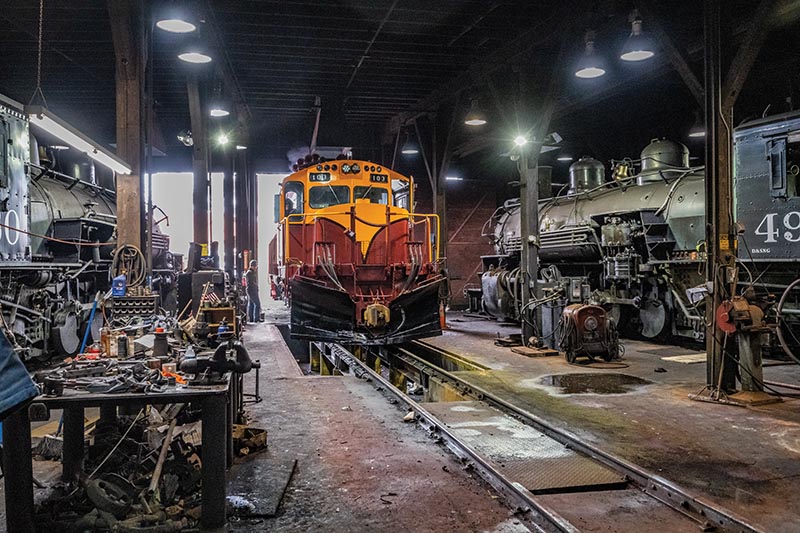
ABOVE: There’s a new face in town as MLW 103 occupies “pit 6” of the Durango roundhouse between veteran Mikados 482 and 493. To date, this pit has served as the main diesel shop. —Jerry Day photo
The closure didn’t last long, however, as the cruise ship industry was beginning to take hold in Alaska. White Pass reinvented itself and reopened for the growing tourism industry, but unlike its ore-hauling days, it was flush with motive power and the decision was made to sell the DL535s. The unique and powerful locomotives caught the interest of Sociedad Colombiana de Transport Ferroviaro, the National Railway of Colombia. In 1992 locomotives 101, 103, 104, 106, and 107 were sold and loaded on a barge destined for South America.
This lasted only a few years, however, when additional tourist trains created the need for more motive power. In 1999, for a second time, a deal was struck with SCdeTF to buy back all five DL535s and barge them back to Alaska. Of note, locomotive 101 nearly didn’t survive the trip home. Caught in a storm at sea, it broke free from its tie-downs and dangled precariously off the edge of the barge, nearly falling overboard into the Pacific Ocean. A quick detour to Eureka, Calif., saved the locomotive from a watery grave, where it was craned back in place to complete its journey to Alaska. For the next two decades, the fleet of DL535s soldiered on in hauling an ever-increasing number of tourists to the summit of White Pass…


